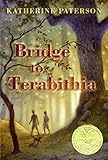Textual Analysis Lesson: Boys vs. Girls: It’s Not Just in Your Head
Lesson Plan
Bridge to Terabithia | 810L

- Learning Goal
- Use the Textual Analysis process to answer comprehension questions about a text.
- Duration
- Approximately 1 Day (25 minutes)
- Necessary Materials
- Provided: “Boys vs. Girls: It’s Not Just In Your Head” Reading Passage (Student Packet, page 20), “Boys vs. Girls: It’s Not Just In Your Head” Textual Analysis Questions (Student Packet, page 21)
Before the Lesson:
Read Chapters 7-9; Complete Student Packet Worksheets for Chapters 7-9
Activation and Motivation
Give each student two sticky notes. Instruct students to write one word on each note that they associate with being a boy and a girl. Next, ask students to come up to the board and stick the “girl words” on one side and the “boy words” on the other side. Have students notice the words used to describe each sex and how they differ. Explain that people have expectations about what it means to be a boy or girl.Explain that in Bridge to Terabithia, Jess and Leslie also encounter gender expectations, either in school or at home. However, both Jess and Leslie possess characteristics that go against many gender expectations. Ask: "Which of the words on the board describe Jess? Which words describe Leslie?"
We will read the Reading Passage, “Boys vs. Girls: It’s Not Just In Your Head” to learn about gender roles and how they impact the lives of boys and girls. Instruct students to carefully follow the steps for Textual Analysis to read the passage and answer the questions that follow. Be sure to have students discuss and prove their answers after they are done.
Before Reading
1. Read the passage title, introduction, and any captions.2. Look at any pictures or photographs.
3. Read the first two sentences only.
4. Stop! Brainstorm what you think the text is going to be mostly about.
5. Read and label the Textual Analysis questions with the Concepts of Comprehension. Do not read the answer choices. Spend only a few seconds labeling each question with the appropriate Concepts of Comprehension.
During Reading
1. Read the whole section of text that was assigned.2. As you read, underline or highlight any information that may help you answer the questions.
3. Have students answer questions independently.
4. Use the process of elimination for any questions for which you are not positive of the answer.
After Reading
1. Prove all of your answers by underlining or copying evidence from the text.2. Go back and check your work. Do your answers make sense? Can you prove each answer?
3. Share your answers with the group. Use text evidence to explain why you think an answer is correct.
Guidance for Questions 5 and 6:
- For Question #5, students should be given an opportunity to explain their interpretation of this sentence. Encourage students to draw on personal experiences to support their thinking.
- For Question #6, before beginning any discussions, students should have a collective understanding of the author’s opinion. Extend the discussion by asking students to support their position with either evidence from the text or personal experiences.
TIP:
Build Student Vocabulary associated
Texts & Materials
Standards Alignment
(To see all of the ReadWorks lessons aligned to your standards, click here.)

Is there a separate reading passage called “Boys vs. Girls: It’s Not Just In Your Head” Textual Analysis? I cannot find it, and the link above loops me back to this same page.
great lessons for Bridge to ..., really brings the story to a personal level ( great excuse to talk about feelings ) especially for students who have moved a lot!
thank you so much for the poetry comprehensions and answers. I used them across all the grades and my staff found them quite useful.
What does it mean by "record the concept of comprehension on the line?"
Hi Karla, thanks for writing and for your interest in ReadWorks - we greatly appreciate it!
Many of the worksheets were originally designed to have students "label" the questions with the corresponding skill/strategy (i.e., Concept of Comprehension). However, that assumes that the students in question have been been explicitly taught all of the skills/strategies in the preceding years leading up to their exposure to the Novel Studies in 5th and 6th grades. As that is likely not the case, consider such "labeling" optional.
For your reference, the list of abbreviations and their associated skills and strategies can be found here: http://www.readworks.org/lessons/skill-strategy-definitions.
Wonderful unit and lessons!! Thanks so much for all of your hard work!!
Where is the student packet for this lesson? I cannot find “Boys vs. Girls: It’s Not Just In Your Head”
Hello! You can find the student packet under the "Teacher & Student Materials" section the unit page here: http://www.readworks.org/lessons/grade5/bridge-terabithia